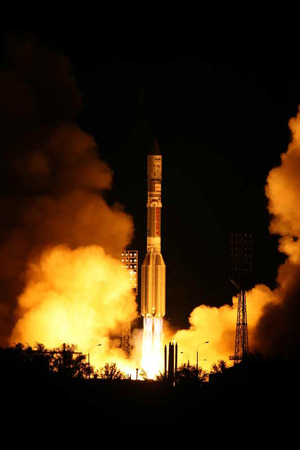New Sirius XM Radio Satellite Blasts Off on Russian Rocket

SiriusXM Radio'snext broadcasting satellite rocketed away from Earth and into spaceThursday,reaching a lofty perch high above Earth for a 15-year mission servingnearly 20million subscribers in North America with music, news and varietyprogramming.
Thecompany's ninth satellite lifted off at1853 GMT (2:53 p.m. EDT) from pad 24 at the Baikonur Cosmodrome inKazakhstan,the first commercial Proton rocket launch from that complex in morethan fiveyears.
TheProtonlofted theSirius XM 5payload on a suborbital trajectory in less than 10 minutes, then aBreeze Mupper stage fired as planned, according to International LaunchServices, theRussian-owned, U.S.-based firm responsible for commercial Proton sales.
Theupper stage fired four more timesovernight to raise its altitude and reduce its inclination, eventuallyarrivingin an elliptical transfer orbit stretching more than 22,200 miles fromEarth atits furthest point.
Deploymentof Sirius XM 5 occurred at 0405GMT (12:05 a.m. EDT) Wednesday, more than nine hours after liftoff.
Thursday'slaunch was the ninthProton flightof the year.It was the sixth mission for International Launch Services.
SiriusXM 5 will firean on-board kick engine several times over the next few weeks to reachan orbit22,300 miles above the equator. Controllers will park the satellite at80 degreeswest longitude for a month of in-orbit testing, then the craft willdrift toits long-term home at 85.2 degrees west longitude.
Get the Space.com Newsletter
Breaking space news, the latest updates on rocket launches, skywatching events and more!
Thesatellite will be an orbital spare forthe XM 3 and XM 4 satellites currently transmitting operational radiosignals,according to Lincoln Day, executive director at Space Systems/Loral,thesatellite's prime contractor.
SiriusXM 5 will join a fleet of spacecraftalready beaming radio signals to receivers in cars, trucks, boats,aircraft,homes and mobile devices of more than 19.8 million subscribers.
"Thesuccessful launch of XM 5 bolstersour continuity of services and will help ensure Sirius XM Radio's audioanddata services are reliably delivered to our customers," said DavidFrear,executive vice president and chief financial officer of Sirius XMRadio."We knew we could count on ILS and Khrunichev to launch on-time andwithflawless precision as they have been demonstrating for us for over adecadenow."
Two29.5-foot-diameter unfurlable meshantennas will broadcast Sirius XM Radio's 135 audio channels. Theantennas willbe connected to an S-band downlink and X-band uplink communicationspayload.
Thesatellite is designed to last for atleast 15 years in space. Based on Loral's 1300 spacecraft bus, SiriusXM 5 willproduce nearly 20 kilowatts of power at the end of its mission.
Therest of the company's broadcasting fleetwas launched under the banner of SiriusSatelliteRadio and XM Satellite Radiobetween 2000 and 2008, when the firms mergedto form Sirius XM Radio. Another Proton launch delivered Sirius FM 5 tospacein June 2009, deploying the company's newest satellite beforeThursday's mission.
"Therelationship we have with Sirius XMRadio dates back to over 10 years with the launch of the Siriusconstellationof three satellites in 2000," said Frank McKenna, president of ILS."The entire team of ILS, Khrunichev, Sirius XM and Space Systems/Loralonce again worked throughout the mission to deliver the XM 5 satellitetoorbit. We thank Sirius XM for entrusting ILS Proton with their businessandallowing us to participate in the making of satellite radio history."
SiriusXM Radio plans to launch anothersatellite, Sirius FM 6, in late 2011 ona Proton rocket.
Thenext Proton will deploy the SkyTerra 1mobile communications satellite for LightSquared and Boeing. Thatmission isslated for liftoff Nov. 14.
- Gallery:ShuttleDiscovery's Last Launch Pad Trip
- Photos:SuborbitalSpaceflight Training with SPACE.com
- Crewof Space ShuttleDiscovery's Final Mission to Stage Launch Rehearsal

Join our Space Forums to keep talking space on the latest missions, night sky and more! And if you have a news tip, correction or comment, let us know at: community@space.com.
Stephen Clark is the Editor of Spaceflight Now, a web-based publication dedicated to covering rocket launches, human spaceflight and exploration. He joined the Spaceflight Now team in 2009 and previously wrote as a senior reporter with the Daily Texan. You can follow Stephen's latest project at SpaceflightNow.com and on Twitter.









